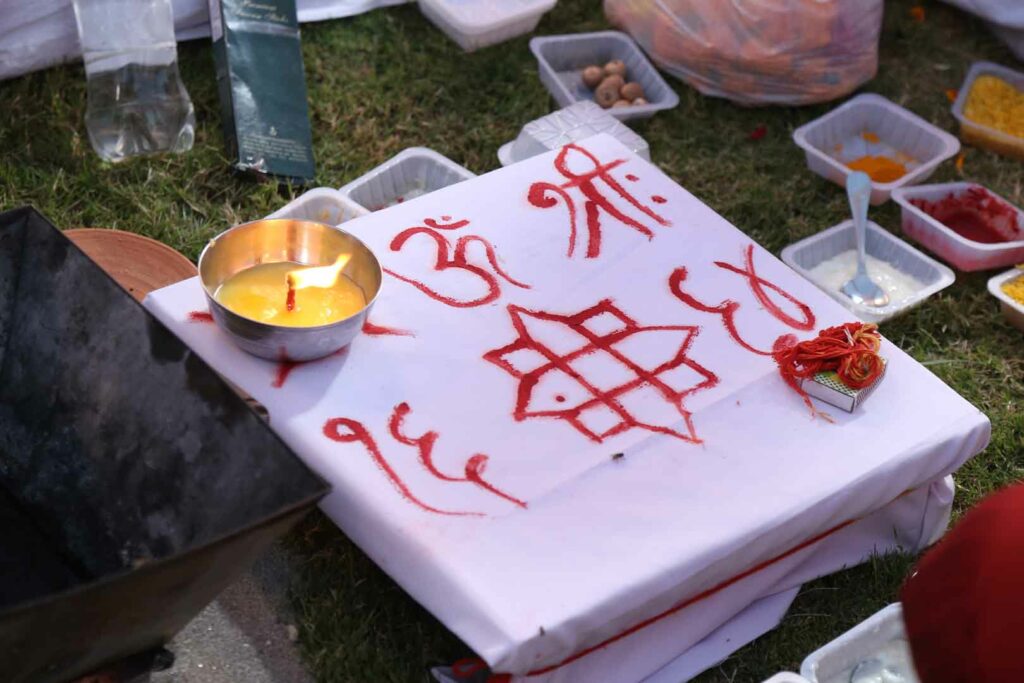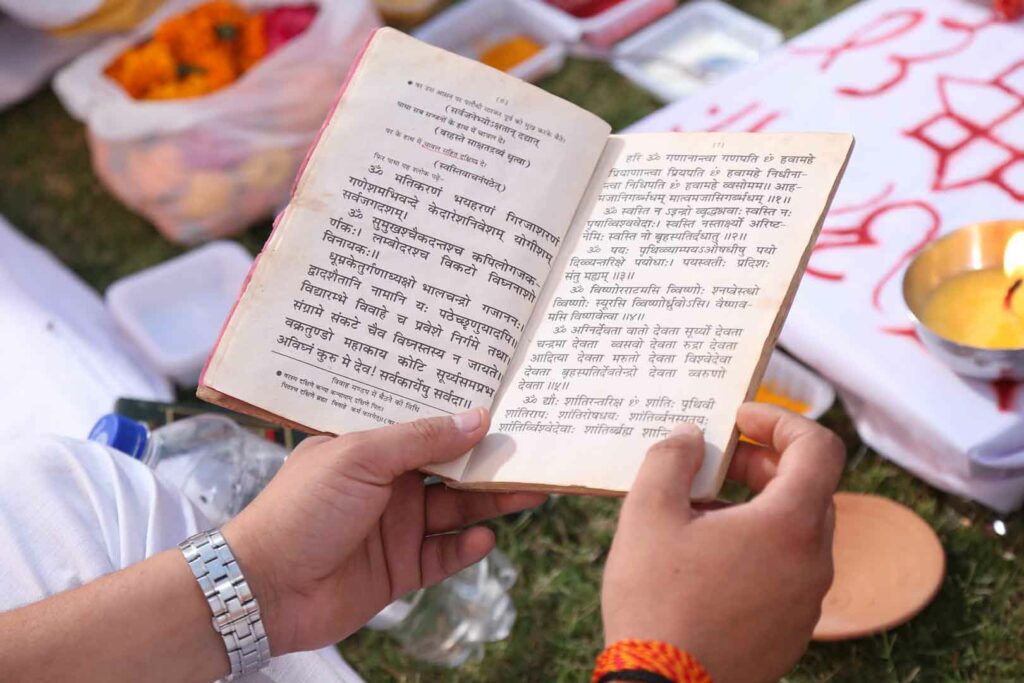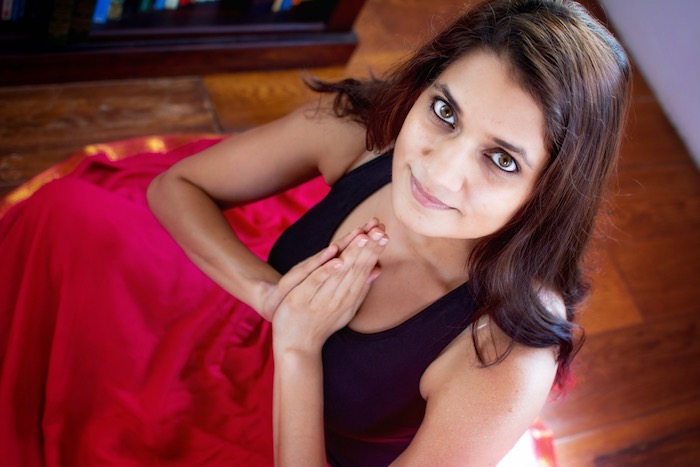Vedas are the sacred texts of Hinduism which were transmitted orally from one generation to another in a very systematic manner. While every religion has a corresponding holy book, the uniqueness of Vedas is that they were meant to be memorized and verbalized and were initially never written down. The Vedic emphasis was not on the textual knowledge which could be preserved in writing, but on correct pronunciation, which could only be preserved by speaking.
So rather than saving the hymns in written script, the Vedic priests worked hard since early childhood to memorize the sacred verses with correct accents and musical tones. They would then teach what they had learned to the next generation, and in this way, the knowledge would be transferred over time. Professor Witzel aptly likened this impeccable transmission of Vedic texts as if it were a well preserved ‘tape recording’ from antiquity.
Where from did the Vedas come?
Popular belief is that the Vedic hymns were ‘heard’ by the sages of ancient times in higher stages of meditation. The lore says that these hymns held within them the secret of creation and their sound vibrations were used by Lord Brahma to create this world. One could consider them the vibratory algorithms of this matrix we call the universe. Because they were ‘heard’ in a state of higher consciousness, they are often also known as the ‘whispers of God.’
There are four Vedas, and they are considered supremely sacred and their word sacrosanct. But the irony is, few if any, know what is in the Vedas. The entire scope of Vedic wisdom is so vast that it is hardly easy for an average person to study them, let alone understand them. It is an overwhelming task for the priests themselves, which is why the entire Vedic compendium is divided amongst different priestly communities. Which means one class of priests will memorize and transmit only one section of the Vedas – thus each one becomes highly specialized and is known by the Veda they studied.
Structure of the Vedas
There are four Vedas namely Rig, Yajur, Sama and Atharva Veda – initially, all Vedas were just one; it was Sage Vyasa (of Mahabharata fame) who divided them into the four sections that we know of today. This division was not random but was derived basis the actual process and usage of hymns in a Vedic ritual.
Each Veda itself is a collection of four different texts which are as follows:
- Samhita: This is the actual collection of all the hymns or Vedic poetry which praises the various Vedic Gods. These hymns were used in the Vedic fire rituals (Yajna) which were performed for many materialistic gains such as winning a war or gaining prosperity/sons or for earning passage to the heavens.
- Brahmanas: These contain stories, legends and the correct methods of performing rituals.
- Aranyakas: These translate as forest treatises ~ some accounts say that these texts include the more precarious rituals which were to be performed in remote areas away from the settlement of ordinary people, such as in the forests. Some other scholars believe these contain injunctions for those who have retired to the forests or are in the Vanaprastha stage of life.
- Upanishads: These are the more popular and easily accessible portion of the Vedas which contain philosophical investigation into the nature of the world and human existence.
So, the actual mantras which are used in the Vedic rituals are only found in the Samhitas. Therefore, for some scholars, the Samhitas alone are the Vedas, and other texts are ancillary. But in India and amongst Hindus, all four texts together are considered the Vedas.
What’s also interesting is the stark contrast between the Upanishads and the Samhitas – the Vedic hymns focus on eulogizing various Gods, conducting elaborate rituals and even animal sacrifices but the Upanishads preach Ahimsa or non-violence, do not promote external ritualism and put greater emphasis on liberating the soul over seeking material pleasures.
What are the Vedic Hymns
- Rig Veda Samhita is a collection of 1000+ hymns praising different Gods.
- Sama Veda Samhita is a collection of select hymns from the Rig Veda but set to a particular meter and tonality. That is, they give us the exact method of how to chant. The word Sama is derived from Saman which means a Song in Sanskrit.
- Yajur Veda Samhita is a collection of some Rig Veda hymns and also some mantras (called Yajus) which are muttered (not chanted) during the ritual.
- Atharva Veda Samhita is a debated addition as many do not consider it to be an authentic Veda. It contains magical chants and spells for prosperity, curing diseases and even to destroy the enemy. Because it mentions herbs and mantras to heal physical ailments, it is said to be the source of Ayurveda.
What is the Vedic ritual like?

Vedic ritual or sacrifice was essentially a fire ritual. An altar with specific dimensions and shape would be constructed, sacred fire (Agni) would be installed. With the chanting of the Vedic hymns, different objects would be offered as a sacrifice into the fire. These objects would generally be of three kinds – grains, animals, and soma (a Vedic drink made from a plant that is no longer known to us). Animal sacrifice and at times even human sacrifice (Purushamedha) is mentioned in the Vedas though it is disputed. Some scholars call human sacrifice ‘symbolic’ and something that was never really done.
The fire was central to a Vedic sacrifice as only fire could take ‘human’ food and transmit it to the Gods. So, fire acted as a carrier of everything that was offered by humans into it. It would take up the ritual offering to the God named by the priest while chanting. Ghee was used for keeping the fire alive throughout the ritual.
All Vedic rituals, rather sacrifices (Yajna) were conducted outdoors in temporary structures which were constructed specially for the ceremony and would be demolished subsequently. The entire process involved the careful construction of an altar of a specific shape with geometric precision. Even the bricks would be made as per the body measurements of the person who commissioned the sacrifice. It could take weeks or months to prepare depending on the type and intensity of the Yajna. What’s notable here is that the Vedic period did not endorse the concept of permanent holy structures like temples or idol worship.
To get a real-life example, I would highly recommend you take a look at this rare footage of a Vedic fire ritual done in 1975 by Namboodari Brahmins of Kerala.
Who are the Vedic Gods?
Now that we broadly know what the Vedas include let’s look at the Gods that the Vedic priests worshipped. If you were thinking Brahma, Vishnu, Shiva, Ganesha or Durga, you’d be wrong. The Vedas barely mention Vishnu and speak of Shiva as Rudra, a dreadful and destructive deity. So, who did they worship?
The most prominent Vedic God was Indra – the king of Heavens. Other prominent gods were Varuna (Lord of the Ocean), Agni (Fire that transmitted the sacrificial offerings to the Gods), Soma (deification of a plant-based drink used in Vedic rituals), Ashwins (The Doctors of the Gods), Surya (The Sun) and so on. It is interesting to see that the ancient Indians were merely worshipping the forces of nature. Even the Goddesses that were worshipped were Prithvi (Earth), Ushas (Dawn), Sarasvati (the river), etc.
Modern Hinduism a mix of Tantra and Veda
Vedas exclusively advocated the fire ritual or Yajna which is rarely practiced in the modern household. What’s more common in Hinduism of our age is idol or temple worship. Over time the complicated and expensive Vedic ritual was replaced by simpler forms of worship and the Brahmin community also adapted to this change.
As per Oxford Professor N. Sutton, the temple worship and newer forms of religion that made its way into Hinduism are not derived from the Vedas but come to us from Tantra or Agamas. For instance, one of the surviving remnants of a true Vedic ceremony is the Indian Wedding where offerings to the fire are still made along with Vedic mantras. Most regular forms of the modern temple and idol worship are Tantric in origin which provided us with the now famous ‘external’ forms of God worship.
Modern Hinduism is thus neither purely Vedic nor entirely Tantric – it has bits of both. Some aver that modern temple worship is indeed Vedic in origin. It is just more suited for Kali Yuga or this dark age that we are in, where the fire ritual would be impractical. People needed more accessible forms of Yajna and temple worship came to be.
A quick mention of the Upanishads
Upanishads are the last section of the Vedas and therefore are called Vedanta (end of the Vedas). They are more philosophical and talk about the emancipation of the human soul. The Vedic ritual is geared towards providing material prosperity or better worldly life; it does not help one escape from the cycle of birth and death. Conversely, the Upanishads contain the key to escape from this karmic cycle of rebirth. They transition away from the external or ostentatious rituals and focus more on self-inquiry and individual effort to arrive at the ultimate truth.
There are hundreds of Upanishads, but only about a dozen are considered essential, these are known as Mukhya Upanishads. Here’s a Wikipedia link that gives the complete list.
Ritualism vs. Spiritualism

There’s a stark difference between the ritualism of the Vedas and spiritualism of the Upanishads. Visionaries like Swami Vivekananda, Ramanuja, Dayananda Sarasvati and of course Adi Shankara have tried in their respective lifetimes to shift the focus away from rituals and to establish the authority of Upanishads. Even Krishna in the Bhagavad Gita condemns those who follow the letter of the Vedas without understanding the real purpose of human life. The wise emphasize that one should strive for knowledge and not rituals. But that is not the way of the world today.
Conclusion
Thus, we see that Vedic worship was exclusively centered around the fire ritual or sacrifice called Yajna. It was more suited for those who wished for material gains and prosperity. On the contrary, the Upanishads speak of liberation of the soul – rather than immersing ourselves in worldly pursuits; they encourage us to practice detachment and acceptance. It is the great divide in Hinduism today – which method is better? I think that’s for each one of us to discover for ourselves.





